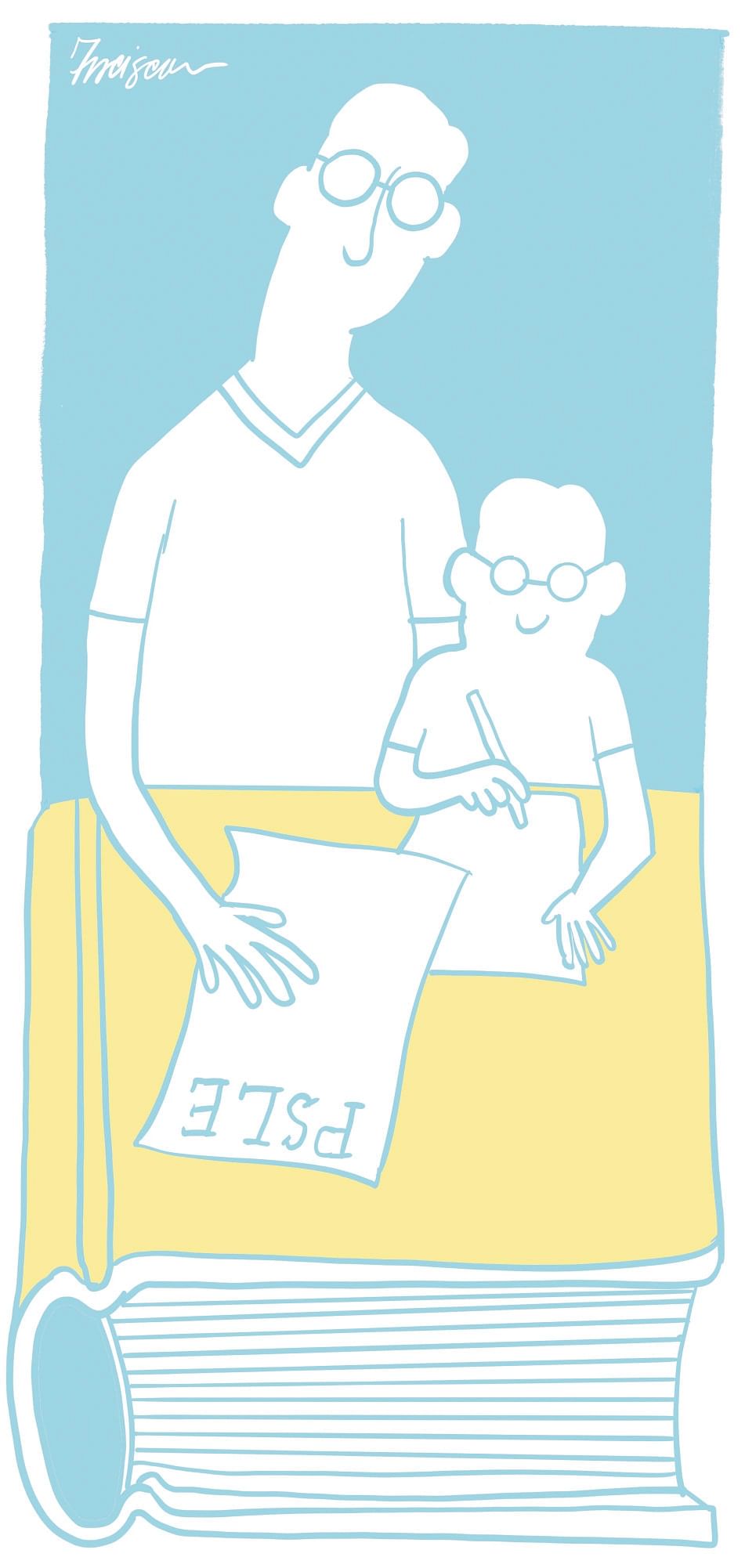My husband quit his job because of PSLE. But was it worth it?
Hint: His stint as a stay-at-home dad lasted only a few months. But for men who stop working for longer, what is the financial and social reality that confronts them?

This time last year, my husband left his job to coach my child for the Primary School Leaving Examination (PSLE). We had fretted over the decision for months, knowing that his career break could easily become career-ending.
We weren’t aiming for the stars, expecting our child to get the best possible total score of 4. Rather, we hoped to give her last-mile support to get into a secondary school near our home.
Still, it was a nerve-racking few months leading up to the exams in October.
My husband ferried our daughter to and from school every day. On top of sending her to tuition classes, he slogged through piles of assessment books and past-year exam papers with her.
Having spent years like two ships passing in the night – we both work unpredictable hours – having a stay-at-home spouse, even if only for a few months, was a thoroughly spoiling experience.
In the past, our children waited for me to come home to solve problems with their homework.
But now, he tackled all the homework and I focused on my job. We also ate freshly cooked meals every day instead of buying takeaway.
This arrangement reminded me of my childhood growing up in a single-income family in the 1980s, except that it was my mother who stayed at home.
But the fear was always there: Would my husband have trouble returning to the workforce?
Potential employers expressed doubts that he had voluntarily left his job.
The subtext was unspoken, yet clear: Did you get fired? Surely, only women take time off work to coach their children? Are you lazy? How committed will you be to your next job?
Stay-at-home dads face social stigma
My husband missed the company of his colleagues and the intellectual stimulation of work. He knew that being a stay-at-home dad (SAHD) was not his cup of tea, and found a job once PSLE was over.
But other men, by choice or compulsion, exit the labour force for longer stretches of time or even permanently.
According to the Ministry of Manpower’s Labour Force in Singapore report, in 2022, there were 10,200 men outside the labour force – meaning they were not working and not actively looking for nor available for work – who cited family responsibilities as the main reason.
Such responsibilities include housework, care for one’s own children, and care for families or relatives other than one’s children.
This number is lower than the 14,100 men in 2021, but still higher than the 6,800 in 2012.
In 2022, these men comprised 2.6 per cent of male residents aged 15 and older who were outside the labour force, up from 1.8 per cent in 2012. SAHDs are just one subset of these men.
Among women, the opposite is happening.
The number of women outside the labour force – who cited family responsibilities as the main reason for not working – fell from 299,200 in 2012, to 239,100 in 2021 and 2022.
In 2022, these women comprised 36.4 per cent of female residents aged 15 and older outside the labour force, down from 43.3 per cent in 2012.
Assistant Professor Tan Poh Lin at the Lee Kuan Yew School of Public Policy (LKYSPP) told me that with an ageing population and shrinking family networks – Singapore’s total fertility rate fell to a historic low of 1.04 in 2022 – more men will find themselves involved in caregiving.
But, said Association of Women for Action and Research (Aware) executive director Corinna Lim, unless gender norms and stereotypes are addressed – such as through comprehensive sexuality education – an equal distribution of caregiving responsibilities between men and women seems “unlikely to happen anytime soon”.
Because of the social stigma SAHDs face, Prof Tan does not foresee that they as a group will approach the size of stay-at-home mums in the near future.
She said: “Such a role has not yet achieved social legitimacy, and is further held back by contradictions with other social norms that play important functions, such as fathers providing for household needs, gender identity and maternal-child bonding.”
Without moral support, both wives and husbands in SAHD households could face a loss in social status, she added.
Husbands in particular sit at an “awkward intersection” of being considered an advantaged group because of the gender wage gap, while simultaneously occupying an economically vulnerable position because they rely on their wives financially, she said.
“I lost my circle of friends”
One dad who understands this well is Mr Martin Leong.
After he was retrenched in 2017, the 48-year-old held various jobs in the food and beverage and insurance broking industries, and at one point was a private-hire car driver.
But all these left him with little time for his 13-year-old daughter, who was being bullied at school and had difficulties with her studies.
“It was logical for me to give up my job, as my wife’s business start-up has shown so much potential for growth,” he said, explaining his decision to become a SAHD in 2022.
“Also, I’m more of a family man who can cook and do household chores.”
Today, he manages the operations for his wife’s business from home. While his parents were supportive of the move, his friends were less so, he said.
“They won’t tell you, but you can feel that they have this impression of you: ‘Oh you’re a man, you’re a chartered accountant, and yet your wife is the sole breadwinner.’”
He admitted that after spending 15 years as his family’s main breadwinner, it was difficult adjusting to his new role.
“I lost my circle of friends. I stay at home every day and my social life has become very limited,” he said, adding that he recently took up cycling as a hobby.

Mr Leong hopes there can be more support for caregivers of young children.
He pointed out that SAHDs also face burnout and isolation – “I basically have no colleagues now” – yet support groups today cater mainly to caregivers of the elderly and ill.
What helped, he said, was having other fathers in his church who had been through a similar experience.
Ms Theresa Pong, the founder and counselling director at The Relationship Room, a counselling private practice, said that unlike women who reach out for companions or join support groups in stressful situations, men tend to cope with their struggles by themselves.
SAHDs in particular, she said, could be facing their children throughout the day with no other social connections.
She recommends that they pursue hobbies or interests to build a positive outlook.
“Dads can continue to upgrade themselves through courses so that when their children are old enough, they can still go back to the workforce or even embark on businesses.”
Couples must also deal with the changes in family dynamics openly and honestly, and iron out practical arrangements such as the roles and duties of each party, said Ms Pong.
They should also be mindful and show empathy to each other, she added.
“It is not about comparing who does more in the relationship nor adopting a ‘50-50 contribution’ mentality.”
Workplace practices matter
But the solutions don’t begin and end at home; workplace practices matter too. It was announced during this year’s Budget that working fathers of Singaporean children born on or after Jan 1, 2024 can now take four weeks of government-paid paternity leave, up from the current two weeks, depending on their employers.
That said, Singapore’s current policies around maternity and paternity leave still reinforce gender role stereotypes, which may explain the “relatively sluggish shift” in gender norms pertaining to work and care, said Aware’s Ms Lim.
“The disparity between (four weeks of paternity leave) and the 16 weeks granted to working mothers remains significant.
“Even if fathers fully utilise their shared parental leave, their total leave quantum amounts to only half that granted to working mothers,” she said, adding that this reinforces the notion that women are primarily responsible for childcare and by extension, caregiving in general.
“We recommend that maternity and paternity leave be equalised to better reflect the equal responsibility that both parents have in raising their children.”
Nor is it just about increasing paternity leave at the earliest stage of a child’s life.
It is worth considering what kind of work culture will allow parents to stay engaged throughout the schooling years, when time spent with parents is no less important to an older child’s well-being.
Here, flexible work arrangements (FWAs) are important. A set of tripartite guidelines on FWAs will be ready by 2024, under which employers will have to consider such requests from employees fairly and properly.
But in the face of the nation’s dismal – and tumbling – fertility rate, will there come a time when stronger action is needed?
As businessman Ho Kwon Ping said at a recent population conference: “If increasing our total fertility rate is an existential imperative and on the same scale of strategic importance as national defence, then there needs to be a mental paradigm shift by not only the Government, but also by industry, by households, to do something much more drastic.”
If we are to accept that this is an existential issue, like climate change, then it cannot be something to be kicked down the road and it cannot be business as usual.
But what sort of stronger measures would be needed?
Ms Lim suggests legislating the right to request FWAs, citing the importance of making flexible work available and normalised for working caregivers regardless of their gender.
She also suggests introducing paid family care leave. To alleviate the financial burden of caregiving, she recommends that the Government introduce a caregiver support grant with cash and Central Provident Fund contributions.
But the authorities have argued that Singapore should not rush into laws that regulate work-from-home arrangements, for example, lest they create workplace rigidity and impede economic recovery.
In the end, the pressures that parents in Singapore face go beyond their homes and immediate workplaces.
As LKYSPP’s Prof Tan wrote in a 2020 article, East Asian economies’ emphasis on early life achievement means that there are high returns from investing in children’s human capital.
The flip side of this coin is the serious consequences of being less successful than others, both for parents and their children.
So long as there is tension between human capital and fertility, raising birth rates in Singapore to replacement levels will take more than “just policy updates and patches”, she said.
For men, this is worsened by conflicting expectations and confusion over the roles they are meant to play: Breadwinner and head of family? Hands-on dad?
In an ideal world, one could be both. But in the real world, choices and compromises have to be made. For those who wish to stay at home, there is that nagging thought of being accused of “mooching off” one’s wife.
My husband knew very clearly what he didn’t want to be – a long-term SAHD. But other men make the opposite choice, and end up paying a hefty financial and emotional price.
It’s about time the decision either way – for men and women alike – didn’t have to be so difficult.
Join ST's Telegram channel and get the latest breaking news delivered to you.









No comments:
Post a Comment